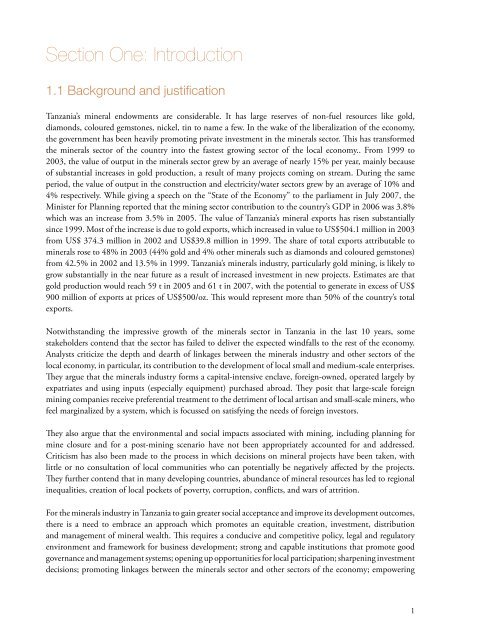Promoting Mineral Clusters: The Case of Tanzania - Africa Mining ...
Promoting Mineral Clusters: The Case of Tanzania - Africa Mining ...
Promoting Mineral Clusters: The Case of Tanzania - Africa Mining ...
- No tags were found...
You also want an ePaper? Increase the reach of your titles
YUMPU automatically turns print PDFs into web optimized ePapers that Google loves.
Section One: Introduction1.1 Background and justification<strong>Tanzania</strong>’s mineral endowments are considerable. It has large reserves <strong>of</strong> non-fuel resources like gold,diamonds, coloured gemstones, nickel, tin to name a few. In the wake <strong>of</strong> the liberalization <strong>of</strong> the economy,the government has been heavily promoting private investment in the minerals sector. This has transformedthe minerals sector <strong>of</strong> the country into the fastest growing sector <strong>of</strong> the local economy.. From 1999 to2003, the value <strong>of</strong> output in the minerals sector grew by an average <strong>of</strong> nearly 15% per year, mainly because<strong>of</strong> substantial increases in gold production, a result <strong>of</strong> many projects coming on stream. During the sameperiod, the value <strong>of</strong> output in the construction and electricity/water sectors grew by an average <strong>of</strong> 10% and4% respectively. While giving a speech on the “State <strong>of</strong> the Economy” to the parliament in July 2007, theMinister for Planning reported that the mining sector contribution to the country’s GDP in 2006 was 3.8%which was an increase from 3.5% in 2005. <strong>The</strong> value <strong>of</strong> <strong>Tanzania</strong>’s mineral exports has risen substantiallysince 1999. Most <strong>of</strong> the increase is due to gold exports, which increased in value to US$504.1 million in 2003from US$ 374.3 million in 2002 and US$39.8 million in 1999. <strong>The</strong> share <strong>of</strong> total exports attributable tominerals rose to 48% in 2003 (44% gold and 4% other minerals such as diamonds and coloured gemstones)from 42.5% in 2002 and 13.5% in 1999. <strong>Tanzania</strong>’s minerals industry, particularly gold mining, is likely togrow substantially in the near future as a result <strong>of</strong> increased investment in new projects. Estimates are thatgold production would reach 59 t in 2005 and 61 t in 2007, with the potential to generate in excess <strong>of</strong> US$900 million <strong>of</strong> exports at prices <strong>of</strong> US$500/oz. This would represent more than 50% <strong>of</strong> the country’s totalexports.Notwithstanding the impressive growth <strong>of</strong> the minerals sector in <strong>Tanzania</strong> in the last 10 years, somestakeholders contend that the sector has failed to deliver the expected windfalls to the rest <strong>of</strong> the economy.Analysts criticize the depth and dearth <strong>of</strong> linkages between the minerals industry and other sectors <strong>of</strong> thelocal economy, in particular, its contribution to the development <strong>of</strong> local small and medium-scale enterprises.<strong>The</strong>y argue that the minerals industry forms a capital-intensive enclave, foreign-owned, operated largely byexpatriates and using inputs (especially equipment) purchased abroad. <strong>The</strong>y posit that large-scale foreignmining companies receive preferential treatment to the detriment <strong>of</strong> local artisan and small-scale miners, wh<strong>of</strong>eel marginalized by a system, which is focussed on satisfying the needs <strong>of</strong> foreign investors.<strong>The</strong>y also argue that the environmental and social impacts associated with mining, including planning formine closure and for a post-mining scenario have not been appropriately accounted for and addressed.Criticism has also been made to the process in which decisions on mineral projects have been taken, withlittle or no consultation <strong>of</strong> local communities who can potentially be negatively affected by the projects.<strong>The</strong>y further contend that in many developing countries, abundance <strong>of</strong> mineral resources has led to regionalinequalities, creation <strong>of</strong> local pockets <strong>of</strong> poverty, corruption, conflicts, and wars <strong>of</strong> attrition.For the minerals industry in <strong>Tanzania</strong> to gain greater social acceptance and improve its development outcomes,there is a need to embrace an approach which promotes an equitable creation, investment, distributionand management <strong>of</strong> mineral wealth. This requires a conducive and competitive policy, legal and regulatoryenvironment and framework for business development; strong and capable institutions that promote goodgovernance and management systems; opening up opportunities for local participation; sharpening investmentdecisions; promoting linkages between the minerals sector and other sectors <strong>of</strong> the economy; empowering1
















